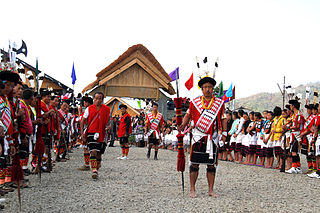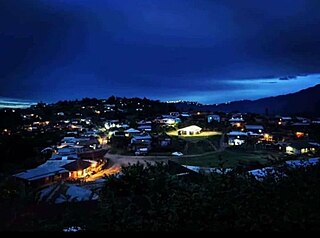
Nagaland is a state in the north-eastern region of India. It is bordered by the Indian states of Arunachal Pradesh to the north, Assam to the west, Manipur to the south, and the Naga Self-Administered Zone of the Sagaing Region of Myanmar (Burma) to the east. Its capital city is Kohima and its largest city is the twin Chümoukedima–Dimapur. The state has an area of 16,579 square kilometres (6,401 sq mi) with a population of 1,980,602 as per the 2011 Census of India, making it one of the smallest states of India.

Nagas are various ethnic groups native to northeastern India and northwestern Myanmar. The groups have similar cultures and traditions, and form the majority of population in the Indian state of Nagaland and Naga Self-Administered Zone of Myanmar (Burma); with significant populations in Manipur, Arunachal Pradesh and Assam in India; Sagaing Region and Kachin State in Myanmar.

The Naga Hills, reaching a height of around 3,825 metres (12,549 ft), lie on the border of India and Burma (Myanmar). They are part of a complex mountain system, and the parts of the mountain ranges inside the Indian state of Nagaland and the Burmese Naga Self-Administered Zone are called the Naga Hills. The highest point of the Naga hills is Mount Saramati.
The Aos are a major Naga ethnic group native to Mokokchung District of Nagaland in Northeast India. Their main territory is from Tsüla (Dikhu) Valley in the east to Tsürang (Disai) Valley in the west in Mokokchung District.

Mon District is a district of Nagaland, a state in India. It is the third-largest district in Nagaland in terms of area. The district has a population of 250,260 people. Mon Town is the headquarters of the district.

Tuensang District (Pron:/ˌtjuːənˈsæŋ/) is a district in Nagaland, North-East India. Its headquarters is in Tuensang town.

Zünheboto District (Pron:/ˌzʌnˈhiːbəʊtəʊ/) is a district in the Indian state of Nagaland. Sümi Nagas are indigenous to this district.

Tuensang is a town located in the north-eastern part of the Indian state of Nagaland. It is the headquarters of the Tuensang District and has a population of 36,774. The town was founded in 1947 for the purpose of administrating the erstwhile North Eastern Frontier Agency (NEFA) that comprised the present day Districts of Tuensang, Mon, Longleng, Kiphire, Noklak and Shamator. Today, these six districts combined are also known as 'Eastern Nagaland'.

Kiphire District (Pron:/ˈkɪfɑɪə/) is a district in the Indian state of Nagaland. It is native to the Sangtam Nagas. At 1,130 square kilometres (440 sq mi), as of 2011 the district is the tenth-most populous district of Nagaland. It was craved out of Tuensang district becoming a district in 2004 along with Longleng district. Headquartered at Kiphire town, the district is 230 kilometres from state-capital Kohima.
The Lothas, also known as Kyongs are a major Naga ethnic group native to Wokha District in the Northeast Indian state of Nagaland.

The Sümis are a major Naga ethnic group native to the northeast Indian state of Nagaland.
Sangtam, also called Thukumi, Isachanure, or Lophomi, is a Naga language spoken in northeast India. It is spoken in Kiphire District and in the Longkhim-Chare circle in Tuensang district, Nagaland, India.
The Khiamniungans are a Naga ethnic group, with approximately 35% of the population inhabiting in Noklak District in the Northeast Indian state of Nagaland and the rest in the Naga Self-Administered Zone and Hkamti District of Myanmar. They were also called Kalyo-Kengnyu during the British Raj.

The Yimkhiungs are a Naga ethnic group inhabiting the territories of Shamator and Kiphire District in the Northeast Indian state of Nagaland and western areas of Myanmar.
Imtilemba Sangtam was an Indian politician and member of the Bharatiya Janata Party. Sangtam was a member of the Nagaland Legislative Assembly from the Longkhim Chare constituency in Tuensang district. Then He joined Nationalist Congress Party and now he is state president of NCP Nagaland.

Noklak District is the 12th district of the Indian state of Nagaland. It was established on January 20, 2021. Noklak, the eponymous town, is the headquarters of the district.

Shamator District is the 16th district of the Indian state of Nagaland. It was created on 19 January 2022 and was officially inaugurated on 4 March 2022. The district headquarter is located in the town of Shamator.
The following is a list of articles relating to the Indian state of Nagaland, sorted in alphabetical order.
Frontier Nagaland is a region of the Indian state of Nagaland. It comprises the eastern districts of Nagaland.











